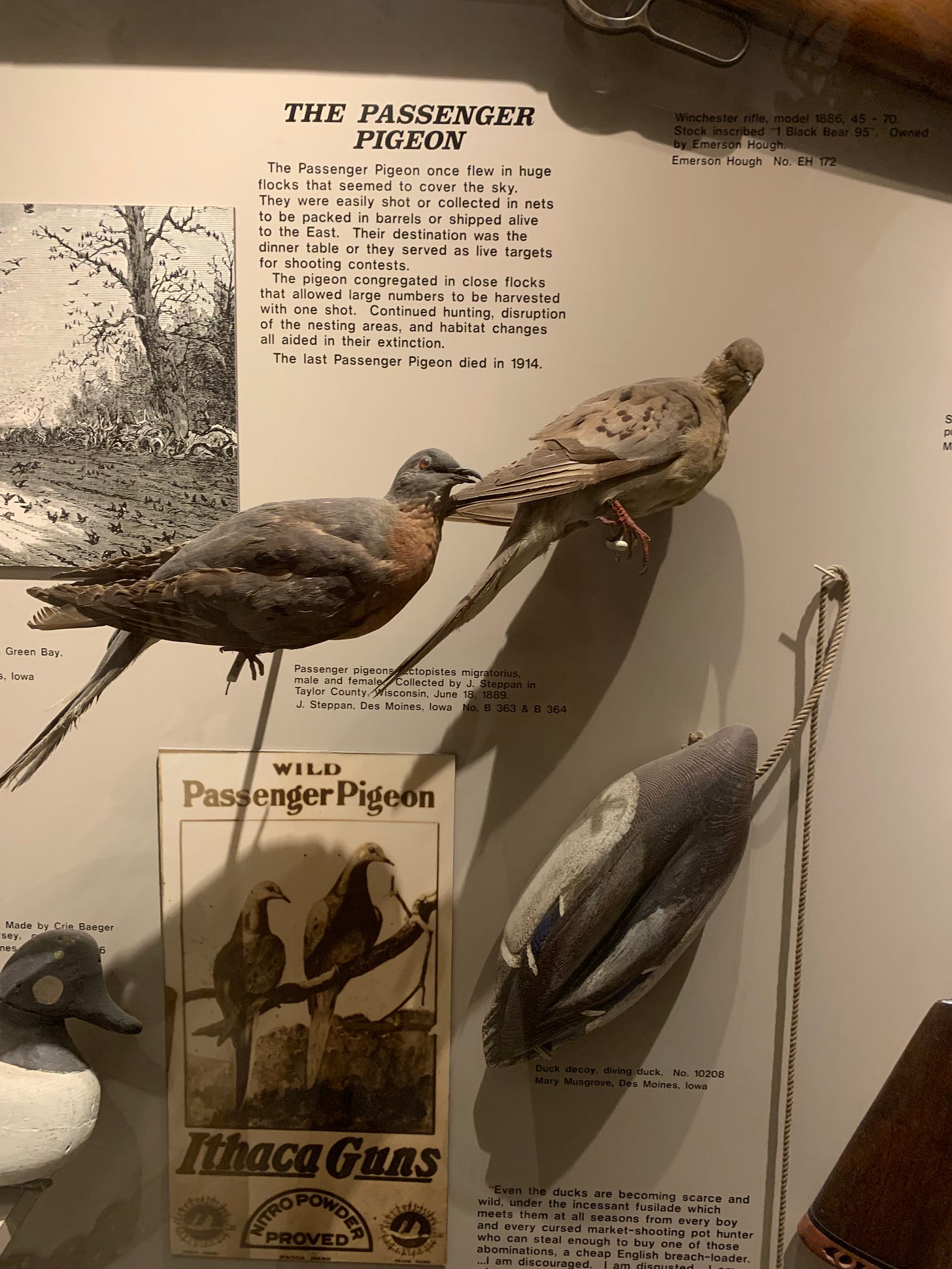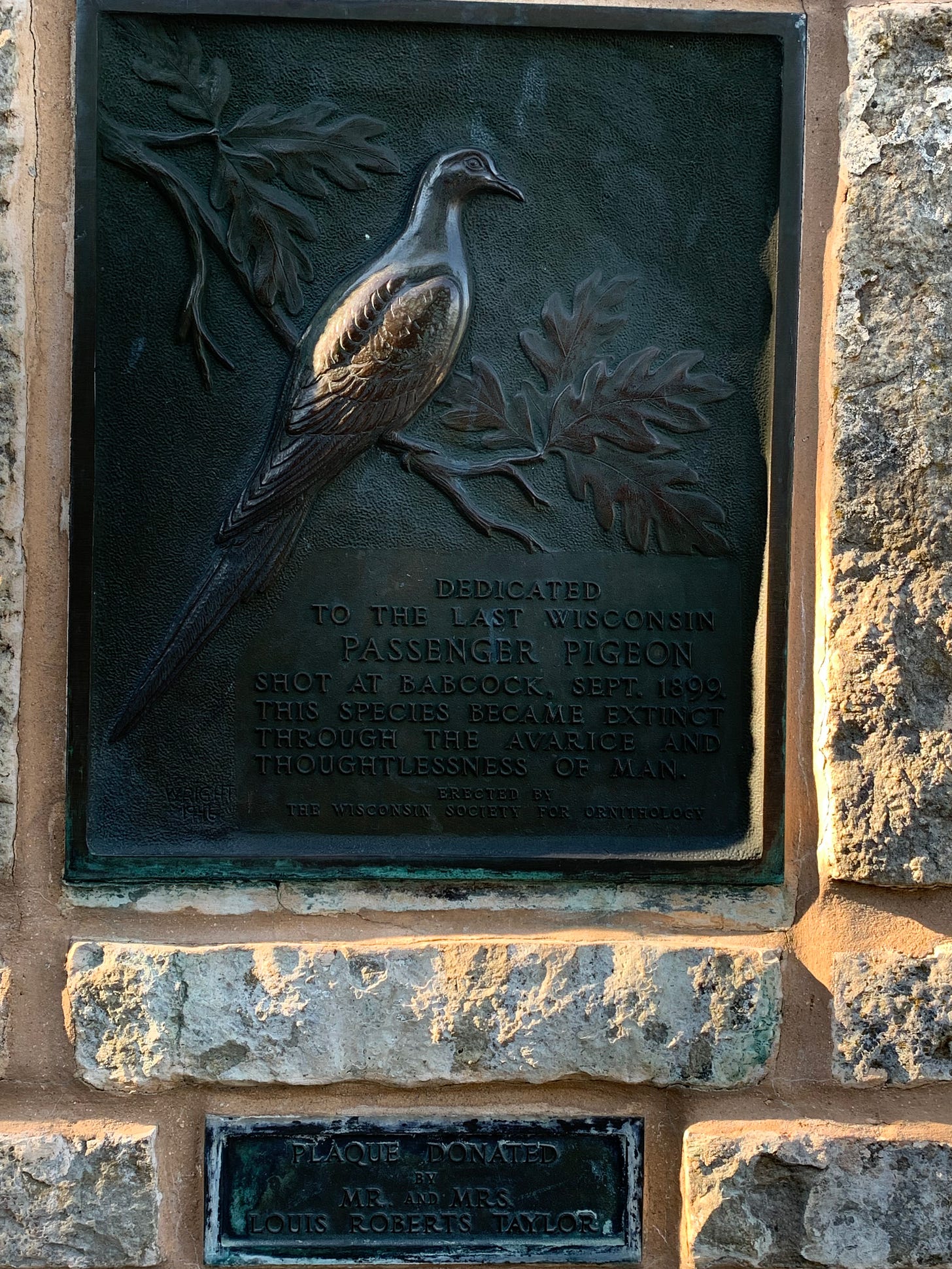Portraits of Ghosts: Extinct Animals Whose Images Haunt Us
Remembering not very long gone animals and the chilling effect of their images and songs.
Portraits of Ghosts: Extinct Animals Whose Images Haunt Us
K.L. Orion
When I was really little, my parents took me up to the Iowa State Historical Building in Des Moines to see one of the coolest things my tiny child brain had seen yet. Dinosaur skeletons aren’t exactly commonly displayed in Iowa, usually only seen on visiting exhibits to the Science Center. However, there was the cast of the skeleton of a behemoth who used to roam Iowa permanently on display at this museum: a mammoth. The colossal beast’s bones inspired wonder in me that kept me wanting to come back again and again.
This past summer, well over a decade after I first saw this skeleton, I wanted to see it again. Unfortunately, the mammoth mount was under renovation when we arrived. That increased my attention to the other exhibits. Browsing through the museum I had been through a million times before, but this time with more focus, I found a few things I had never noticed before. Some of the things I realized on that visit just came to me with age; being older, I understood them more. However, there was one thing I somehow overlooked everytime I had been there before.
It was in a hunting exhibit, which might explain why I never noticed it before. I’ve never been a fan of hunting or guns. I like seeing animals, not killing them. For the record, I would’ve found the hunting section a lot more interesting if they showed some of the hunters’ trophies with them as well. Rather, the interesting taxidermied animals were mainly in the exhibit next to this one. All you really saw here were old fashioned guns, and as I said, I’m not a fan of guns. But this time around, I noticed that there was indeed a trophy hidden back behind a glass case. It wasn’t a bison, or a deer, or even a turkey. And it certainly wasn’t a mammoth (though I think it was just as interesting as one). To the untrained eye, it was little more than a pigeon or a dove. But I knew better. I was looking at something that hadn’t been seen breathing since 1914.
Yesterday was Halloween, so happy belated Halloween. But with Halloween in my mind, it got me thinking about ghosts. When I think about ghosts, I typically think of the restless souls of the dead with unfinished business. I rarely think about the ghosts who don’t have to knock over a vase or possess a doll to get our attention. Those are the arguably more frightening ghosts. The ones that actually keep you up at night. The ones that actually haunt us as a society.
Images and memories have the ability to haunt us, especially if it’s a good picture. What makes a photograph or any piece of art haunting is if it has an emotional impact on the viewer, usually a more negative impact. Sometimes it’s not a picture or a statue that demands this kind of feeling. Sometimes it’s a corpse.
A passenger pigeon. That day, I found myself looking at the taxidermied body of a passenger pigeon. The passenger pigeon is an extinct bird that once lived in North America. Over the summer, I’d visit more museums and find more of these taxidermied passenger pigeon bodies. Not models, but the real feathers of an extinct animal. I’d even happen to stumble upon a memorial dedicated to them on a Mississippi River bluff in Wisconsin, next to a Native American effigy mound (and I mean right next to one of these mounds - I wrote about these mounds a few weeks ago if you want to check that piece out). There sat a plaque honoring the pigeon, along with an information sign about them.
That sign begged us to imagine with them for a second. It asked us to look out over the beautiful river valley. Then imagine a giant flock of birds that numbers in the millions twirling around in the sky. A sea of birds. Then imagine that sea of birds landing in the valley, taking to their millions of nests in the trees. Less than a century and a half ago, that was a reality. That was a normal sight. Passenger pigeons used to be the most plentiful birds in North America. Their numbers as a full population ran in the billions with individual flocks that could reach the millions. That giant number ironically led to their downfall. It was no mistake those birds were put in a hunting exhibit at the State Historical Building.
Since there were so many, hunters thought they could just shoot and shoot them and they’d be fine. But this reckless act took a toll on their population, and it disturbed nesting habits. This kept going until by the turn of the twentieth century, where they were nearly all gone. The last known one died in captivity in 1914.
This summer, I was surprised to see so many taxidermied extinct birds. It’s really thought provoking. You see this extinct bird on displays in the corners of museums as if they were still alive. As if they are still common. When you see them like this, you don’t immediately think they are extinct. Actually, you usually have to remind yourself they are. And that’s chilling. I went to the State Historical Building to see this giant beast of a forgotten era. The mammoth is really a wondrous creature who lived so long ago we still aren’t entirely sure what it looked like or how it behaved. It lived close enough to coexist and maybe die out because of humanity, but that last idea is debated. But it still feels like this ancient mythical animal.
The passenger pigeon doesn’t feel exactly like that. It feels like it died yesterday. It looks like it could blend in with any old flock of pigeons flying around the city. It doesn’t feel like this fantastical beast from a J.R.R. Tolkien novel. It feels like it should still be here. And yet it doesn’t. Those descriptions of millions upon millions of birds filling midwestern skies like a sea of avians still has me bewildered. The passenger pigeon confuses me. My primate mind doesn’t seem to understand it. Here’s this almost normal animal that isn’t exactly normal that should still be alive but isn’t. There is no debate for what killed it, either. Everyone agrees that man put the passenger pigeon in the grave.
The plaque of the previously mentioned memorial.
There is little debate over what killed the thylacine as well. Call it the Tasmanian tiger, call it the Tasmanian wolf, call it whatever you want, the thylacine was an incredible creature. A marsupial carnivore that went extinct after being hunted and outcompeted by European settlers. When you learn about marsupial evolution, like I have a little bit, you realize how important and honestly strange the thylacine was. It was one of the last great marsupial predators.
What makes it even stranger is the fact that there are people alive now who were alive with the thylacine. It officially went extinct in 1936. That brings up another weird thing. Recent studies have been done suggesting the thylacine might’ve lived up into the 1980s, maybe even the 2000s. There are arguments that it might even be alive today, based on some sightings. The idea that this almost alien creature was around fairly recently and might still be around is just mind boggling.
And then there’s the craziest thing. A biotech company called Colossal is not only trying to bring the thylacine back, but the dodo bird and the woolly mammoth back too. This is a very deep topic and might become an individual post later, but as for now, I’m just going to put a link to their website so you can learn more yourself.
The reason I brought up the thylacine though is this; there is video of it. Not a picture, moving video. It’s haunting watching one of the last of a now extinct animal in an old recording like this.
But there might be something even more haunting.
In 1987, the last Kauai ‘O’o bird died. It was not only the last of its species, but the last of a genus unique to Hawaii. Before it died, its song was recorded for the last time. It sang what had been a duet of its species for millenia. This bird sang a part his father had sung for his mother, his grandfather had sung for his grandmother, and so on. His ancestors sang this song for as long as the islands could remember. But as I said, it was a duet. His mother filled in the gaps of his father’s song. No bird filled in the gaps of his song. Rather, he sang a solo that was supposed to be a duet. He sang a solo for a female; a female that would never come.
I feel like his song is worth a million words, but then again, it isn’t. Words can never do justice to this song. Just listen to his language, and it all speaks for itself. Maybe not clearly, but emotionally. You have to feel it. Listen to him sing. Be haunted not by the image of an extinct animal, but by the voice.






You have tugged at my heartstrings!